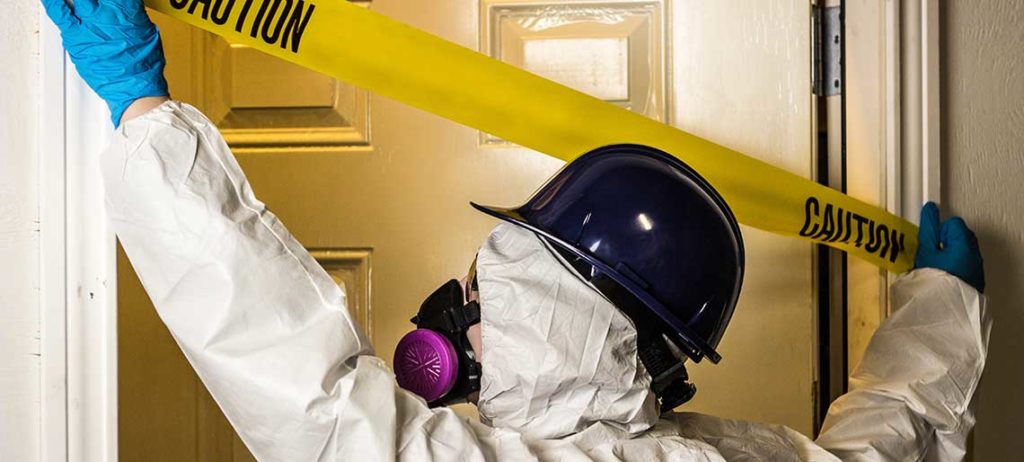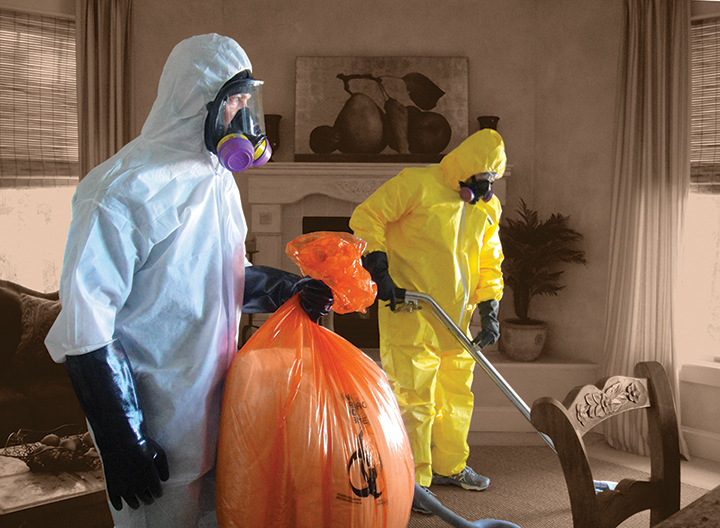Flood Damage Restoration: Quick and Efficient Healing for Your Home
Wiki Article
Expert Biohazard Cleaning and Decontamination for Blood, Bodily Fluids, and Hazardous Materials
In the realm of biohazard cleansing and purification for blood, physical fluids, and hazardous products, accuracy and expertise are paramount. The possible health and wellness dangers related to direct exposure to biohazards highlight the vital requirement for meticulous handling and thorough cleaning. Specialized training furnishes experts with the knowledge and abilities required to address these unsafe circumstances efficiently. However, it is not just about tidying up; the value of employing correct decontamination strategies can not be overstated. As we navigate the complex landscape of biohazard cleanup, recognizing the nuances of laws, conformity, and the specialized tools at play becomes vital in ensuring a secure and comprehensive purification process.
Wellness Risks of Biohazard Exposure
Direct exposure to biohazards postures significant health dangers that can lead to extreme effects for people and communities alike. Biohazards include a vast array of organic substances, including blood, bodily fluids, mold, bacteria, viruses, and other potentially contagious materials. When individuals enter into contact with these biohazards, whether with mishaps, incorrect handling, or environmental exposure, they deal with the risk of contracting major diseases or illness.One of the primary health risks related to biohazard exposure is the transmission of infectious conditions. Bloodborne virus such as HIV, liver disease B and C, and different germs can be present in biohazardous materials, posing a straight hazard to human wellness. Breathing in airborne biohazards like mold spores or entering call with polluted surfaces can also lead to respiratory system concerns, allergies, and other adverse wellness impacts.
Additionally, biohazard exposure can have lasting health and wellness implications, with some diseases showing up years after the preliminary contact (Blood Cleanup). Consequently, it is critical to prioritize proper biohazard cleansing and decontamination to mitigate these wellness risks and make certain the security of individuals and areas

Specialized Educating for Biohazard Cleanup
When it concerns taking care of biohazard cleanup effectively and securely, specialized training plays a fundamental function in making certain appropriate purification treatments are followed. Biohazard cleanup needs certain knowledge and skills to efficiently alleviate threats associated with bloodborne pathogens, bodily liquids, and unsafe products. Professionals learnt biohazard cleanup go through extensive guideline on just how to safely handle, remove, and throw away biohazardous products to avoid contamination and direct exposure.Specialized training for biohazard cleanup covers a range of important topics, including appropriate individual protective tools (PPE) usage, bloodborne pathogen recognition, decontamination strategies, and contaminated materials disposal protocols. People educated in biohazard cleanup are equipped with the essential proficiency to assess contamination levels, identify potential dangers, and carry out proper cleanup procedures in compliance with governing standards.
Constant training and education are paramount in the area of biohazard cleaning to stay upgraded on the most up to date purification innovations, safety and security protocols, and guidelines. By purchasing specialized training, biohazard cleaning professionals can effectively react to emergency cleaning scenarios and safeguard both public wellness and the atmosphere.
Relevance of Proper Decontamination Strategies
Making use of appropriate decontamination techniques is vital in biohazard clean-up to effectively decrease and get rid of hazardous materials health dangers. Effective purification not just makes certain the elimination of visible traces of blood, bodily fluids, and other biohazards but also targets unnoticeable pathogens that might position severe health and wellness dangers otherwise properly removed. By complying with rigid purification methods, educated specialists can considerably minimize the risk of direct exposure to unsafe microbes, infections, and microorganisms that can cause infections or diseases.Proper decontamination strategies entail making use of specific devices and anti-bacterials that are specifically created to reduce the effects of biohazards efficiently. Detailed cleansing and disinfection of contaminated locations are necessary to stop the spread of pathogens and make sure a safe environment for passengers. Additionally, the proper disposal of biohazardous waste complying with decontamination procedures is vital in protecting against contamination of various other surfaces or individuals.

Tools and Devices for Safe Cleaning
When dealing with blood, bodily liquids, or hazardous materials, biohazard cleaning specialists rely on specialized equipment to decrease direct exposure threats and completely decontaminate the affected area. Furthermore, biohazard cleansing kits containing disinfectants, absorbent products, and biohazard bags are utilized to safely get rid of and have of infected products.Advanced cleansing devices like hospital-grade anti-bacterials, HEPA-filtered vacuums, and misting machines are used to disinfect surface areas and get rid of biohazards successfully. Specialized equipment such as sharps containers and biohazard waste disposal containers are utilized to securely handle important source sharp objects and biohazardous waste materials. By using the right equipment and tools, biohazard cleaning specialists can guarantee a thorough clean-up process that prioritizes safety and minimizes health risks for both employees and owners of the affected room.
Rules and Conformity in Biohazard Cleansing
Correct adherence to guidelines and conformity requirements is critical in biohazard cleansing to guarantee the safety of both employees and the atmosphere. Government firms such as OSHA (Occupational Security and Health Administration) and the EPA (Epa) have developed specific standards for biohazard cleaning treatments to lessen health risks and environmental contamination. These guidelines cover a variety of facets consisting of the handling, transportation, and disposal of biohazardous materials, along with the required training and protective equipment needed for employees included in the cleaning process.Biohazard cleaning companies have to stay up-to-date with these regulations to guarantee that their procedures satisfy the needed safety requirements. Failing to comply with these policies can result in extreme effects, including penalties, lawsuit, and jeopardizing the health of individuals and the atmosphere. By complying with strict laws and conformity measures, biohazard cleansing companies can successfully minimize risks and make certain a secure and comprehensive cleanup process for all celebrations entailed.
Final Thought
Finally, biohazard cleaning and decontamination need specialized training, does bleach clean up blood correct strategies, and adherence to regulations. Exposure to blood, bodily fluids, and dangerous materials postures considerable health dangers, making it important to make use of the best tools and devices for safe cleanup. By adhering to stringent protocols and standards, specialists can properly alleviate the dangers linked with biohazard direct exposure and make sure the safety of both themselves and others.
As we navigate the intricate Clicking Here landscape of biohazard cleaning, comprehending the nuances of regulations, compliance, and the specific equipment at play becomes essential in ensuring a risk-free and complete purification procedure. (Blood Cleanup)
When it comes to taking care of biohazard clean-up efficiently and securely, specialized training plays an essential role in ensuring appropriate decontamination procedures are followed.Utilizing correct purification techniques is crucial in biohazard clean-up to effectively remove hazardous products and reduce wellness dangers. Additionally, biohazard cleansing sets consisting of disinfectants, absorbent materials, and biohazard bags are made use of to safely contain and get rid of of contaminated things.
Federal government agencies such as OSHA (Occupational Security and Wellness Management) and the EPA (Environmental Defense Agency) have actually established particular guidelines for biohazard cleanup treatments to minimize health dangers and environmental contamination.
Report this wiki page